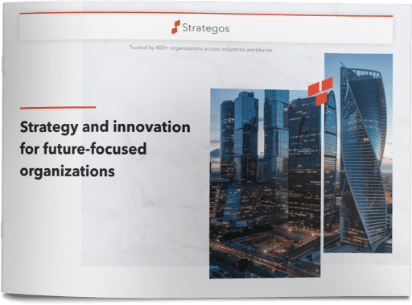At the beginning of August 2011, Apple briefly eclipsed Exxon as the world’s largest company by market capitalization, a remarkable fact given that when Steve Jobs returned to take charge 14 years ago, it was on the verge of bankruptcy.The amazing success that Apple has enjoyed has been achieved through bringing game-changing products and services to market as well as inventing entirely new business models that have revolutionized industries. In the case of Apple it is widely accepted that this is proof that a focus on innovation works and that a continued investment and commitment to innovation – and building a culture of innovation – brings substantial rewards over time.But clearly not every company can be Apple and not every CEO can be Steve Jobs[1]… so how can companies build a culture of innovation and utilize all of the assets of their business to drive success? In this Update we discuss this and outline an overall 4-step approach to implementing an innovation culture.
Culture – that indefinable thing? Or is it?
At Strategos we have been advising companies for nearly 20 years on how to implement an innovation culture and use the power of innovation as a transformative mechansim. We believe that all businesses can build a culture of innovation in the same way that they can successfully build a “quality culture” or a “safety culture” or a “customer service culture”. As with these other dimensions of overall corporate culture, it is necessary to have a systematic approach as well as a committed leadership who believe that, over time, such a culture change will lead to them out-performing their competition.
In the following paragraphs we outline 4 clear steps that have helped organizations across different industries become more innovative.
Step 1 – Developing an Innovation Ambition
The innovation ambition is the foundation of the innovation culture. It defines the kind of organization that we want to become, the elements of our approach to innovation, and the organizational principles by which we live as an innovative company?
In order to develop the ambition, we find that it helps to start by asking – ‘What do we normally see in place in organizations where there is a strong culture of innovation’? In our experience, the following six elements are nearly always in place:
1. There is a clear ‘innovation strategy’ that sets out how innovation will ‘contribute strategically’ to the business over a 5-10 year timeframe.
2. The organization uses a simple, robust and proven approach to innovation that allows the progression of ideas from initial stimulus through to implementation in the marketplace.
3. A significant number of employees are involved in the process either to drive innovation themselves or to support the progress of others.
4. Support mechanisms and resources exist to encourage the use of a consistentinnovation process e.g. toolkits, internal champions or experts, formal training programmes etc.
5. Knowledge is systematically captured and the organization recognizes the value of experimentation and the benefits of learning from each innovation project.
6. Innovation is embedded in the Performance Management System – results matter and employees are rewarded accordingly.
So a necessary first step for any organization is to think very carefully about what an innovation culture means to them; what are the key elements of innovation culture that ©Copyright Innovaro 2011. All rights reserved.make up their “Framework” and what will it look and feel like when they have implemented this change in culture.
Step 2 – Diagnosing Current Status
Having defined an innovation ambition and “framework” of what an innovation culture means, the next step is to understand how the organization measures against it, e.g., does it have a simple, flexible process that is proven in delivering new products and services into the marketplace? What proportion of employees are involved in any form of innovation activity? What mechanisms are in place to support innovation?
This upfront measurement phase is crucial in that it provides key data points that can be used to inform the “framework” and define high-impact interventions.
The necessary information is obtained via a combination of primary and secondary data gathering e.g. interviews with a cross-section of employees, analysis of performance metrics, benchmarking to aspects of best practice. This might tell us, for example, that we are great at idea generation and have fantastic tools to enable this but we never actually do anything with these ideas … or that we are fantastic at concept design but lack the skills and experience to quickly launch and learn from prototypes. In this phase we can attempt to uncover the key enablers and barriers to innovation by asking questions such as .. ‘what innovations have been implemented in recent years and how did they happen’ or ‘what innovative opportunities were missed, and what was the root cause of that’. All of the above are useful findings that we take into the next phase.
Step 3 – Designing and Testing
This phase uses the initial findings to design and pilot a new approach to innovation that is aligned with the strategic and organizational outcomes contained in the innovation ambition, and addresses the key issues uncovered in the diagnostic. Typically this pilot will be conducted within one SBU or as a cross functional global programme targeting one specific innovation theme.
Such pilots can be considered to be ‘mini-journeys’ that are used to refine the change model and also generate some real value on a specific subject.
For example:
Assume that one of the key elements of our Culture Framework is a simple, flexible and consistent process for innovation but we have discovered that not only do we have 10 different innovation processes in the organization but that none of them are adequate for our future needs. This is not an untypical finding and one that can be exasperating …. however it clearly gives us something to build upon. A new process can then be designed and tested via a pilot, and based on the learnings of the pilot, refined further before cascading it out as the ‘recommended formal innovation process’.
In building the design, there are three important lessons to keep in mind:
1. Study and benchmark other organizations, both close competitors and those in completely different industries, that can provide stimulus and practical ideas for the final design.
2. Recognize that it takes time to change culture and we can’t do everything now – build the program as a multi-year roadmap and be prepared to adjust the roadmap based upon progress made.
3. Ensure that there is as much stakeholder engagement as possible and that final designs are validated with as many prospective users as possible.
Step 4 – Implementing the Future Design
This phase is all about timing, prioritization and linkages.
As with all other culture programmes this phase is about carefully planning a series of ‘interventions’ that, over time, will start to change the way the organization perceives itself and the way it is perceived by others.
Key questions to be answered are: What do we need to do first? When should we do it and how does it link to other culture change interventions or other business processes and systems?
For many organizations this is about ‘starting to innovate in a different way’ and hence the focus is usually on putting resources and mechanisms in place so that as manyemployees as possible can start to be involved in the innovation process. It is about getting things done and learning from those initial actions and bringing that learning back to a central team that can make the necessary changes.
Case Study In 2001, Whirlpool, under the leadership of then-CEO Dave Whitman, made a strategic commitment to innovation. They began with an ambition to make innovation the primary driver of strategic growth over the next decade and to create an organization that had the collective values and capabilities to produce a continuous stream of breakthrough ideas. An initial innovation programme introduced a new language and created a new organizational excitement that leadership recognized had the potential to fulfill their ambition. A subsequent global programme was conducted, applying new principles, and gradually the innovation pipeline started to fill: Whirlpool’s global innovation programme is estimated to have generated value of $8 billion to the corporation. Innovation is practiced throughout the business and all geographies are united in the common pursuit of market leading ideas.
Final Thoughts
We recognize that in a short article it is not possible to convey the nuance of such an emotive and complex subject as culture change but we want to emphasize that it is possible to change the way in which companies innovate and that it is possible to change the culture of an organization such that innovation becomes the ‘way that it does business’.Changing culture is a complex organizational challenge, however, it can be reliably approached through a process of defining ambition, diagnostic and process design, and committed implementation.
Authors: Ian Pallister (ian.pallister@strategos.com) is a Managing Director





